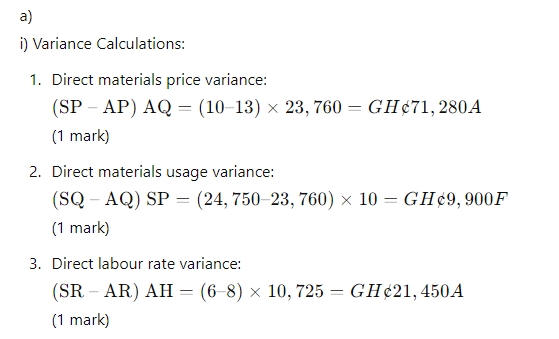- 20 Marks
Question
a) Magawa Ltd operates a standard variables costing system and manufactures a single product called “Magic Touch”.
The following quantities, costs and prices data have been extracted for the period just ended March 31, 2021 in respect of Magic Touch:
Standard cost card:
| GH¢ | |
|---|---|
| Direct materials | 15g at GH¢10/g = 150 |
| Direct labour | 8 hours at GH¢6/hour = 48 |
| Variable overheads | 8 hours at GH¢4/hour = 32 |
| Standard contribution | 25 |
| Standard selling price per unit | 255 |
Budgeted production units: 1,500
Actual results for the period ended March 31, 2021 were as follows:
| Production and sales units | 1,650 |
| Selling price per unit | GH¢278 |
| Direct materials used | 23,760g |
| Direct materials costs | GH¢308,880 |
| Direct labour hours worked | 10,725 |
| Direct labour costs | GH¢85,800 |
| Variable overheads | GH¢68,000 |
Required: i) Compute the following variances for Magawa Ltd for the period ended March 31, 2021:
- Direct materials price variance. (1 mark)
- Direct materials usage variance. (1 mark)
- Direct labour rate variance. (1 mark)
- State ONE (1) possible reason for the material price variance calculated. (1 mark)
- State ONE (1) possible reason for the labour rate variance calculated. (1 mark)
b) The Valuation Department of a large firm of surveyors wishes to develop a method of predicting its total costs in a period. The following past costs and activity levels have been recorded.
| Period | Number of Valuations (V) | Total Cost (TC) GH¢ |
|---|---|---|
| 1 | 420 | 82,200 |
| 2 | 515 | 90,275 |
| 3 | 425 | 82,900 |
| 4 | 500 | 90,000 |
Required: i) Derive a formula for the total cost model for a period. (4 marks) ii) Evaluate the usefulness of the high-low method. (4 marks)
c) The trend line on its own is not sufficient to make forecasts for the future. Estimates of the size of the ‘seasonal’ variation for each of the different seasons are needed. The seasonal variation is then used to adjust a forecast trend.
Required: Explain TWO (2) models used to estimate seasonal variations. (7 marks)
Answer

- Possible reason for the material price variance: Increase in raw material prices due to inflation or shortage of materials. (1 mark)
- Possible reason for the labour rate variance: Increase in wage rates due to higher demand for skilled labour or overtime payments. (1 mark)
b) i) Total cost model using high-low method:
| Period | V | TC (GH¢) |
|---|---|---|
| 2 | 515 | 90,275 |
| 1 | 420 | 82,200 |
Change in TC = 90,275 – 82,200 = 8,075 Change in V = 515 – 420 = 95 Variable cost per valuation = 8,075 / 95 = 85
Fixed cost = TC – (VC × V) Using Period 2: Fixed cost = 90,275 – (85 × 515) = 46,000
Total cost model: TC = 46,000 + 85V (4 marks)
ii) Usefulness of the high-low method:
- Simple and Easy: The high-low method is straightforward and easy to apply for estimating fixed and variable costs.
- Limited Data Requirement: Requires only two data points, making it useful when limited data is available.
- Quick Estimates: Provides quick estimates of cost behavior which can be useful for preliminary analysis.
- Potential Issues: However, it ignores data between the high and low points, potentially leading to inaccuracies if those points are not representative of normal operations. Historical data used may not reflect current conditions. (4 marks)
c) Models used to estimate seasonal variations:
- Additive Model:
- Assumes that seasonal variations above and below the trend line in each cycle add up to zero.
- Steps:
- Calculate the difference between the moving average value and the actual historical figure for each time period.
- Group these seasonal variations into different seasons (e.g., days of the week, months, or quarters).
- Calculate the average of these seasonal variations for each season.
- If the total seasonal variations for the cycle do not add up to zero, spread the difference evenly across each season.
- The adjusted figure is the seasonal variation. (3.5 marks)
- Proportional (Multiplicative) Model:
- Expresses the actual value in each season as a proportion of the trend line value.
- Steps:
- Calculate seasonal variations for each time period by dividing the actual data by the corresponding moving average or trend line value.
- Sum of the proportions for each time period must add up to 1 (or the sum of proportions for quarterly data must sum to 4).
- If the sum does not match, spread the difference evenly over each quarter to adjust the proportions. (3.5 marks)
- Topic: Standard Costing and Variance Analysis
- Series: APR 2022
- Uploader: Joseph
